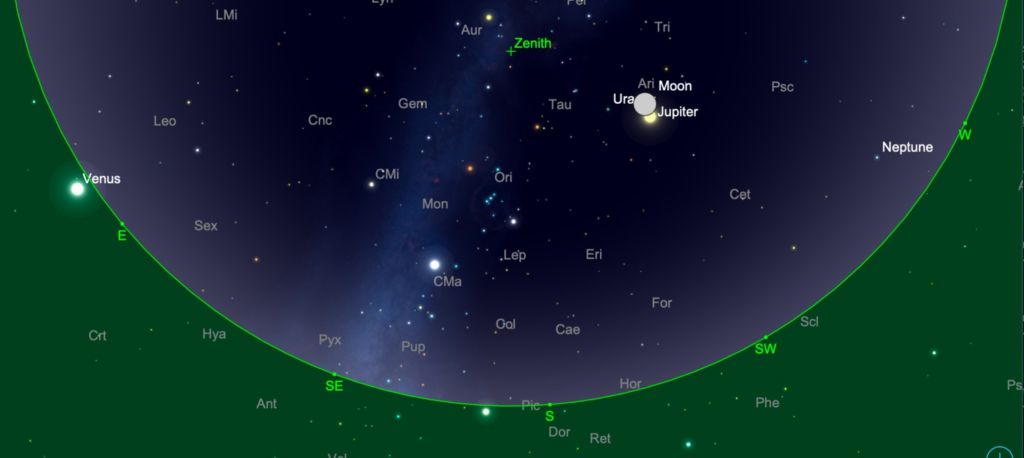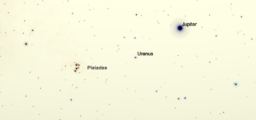Sky Report: October 23 – 29

The southern half of the sky at Venus-rise on the 29th. The moon and Jupiter are just over 3° apart.
The week begins with a wonderful conjunction – and conjunctions are always fun. As the sky is getting dark, look for the nearly-full moon a third of the way up the southwestern sky. On the evening of the 23rd the distant planet Saturn is only 5° straight above the moon. Saturn is 1-hour 17-minutes distant by light; in contrast the moon is 1-1/5 light seconds distant. You’ll see both together in standard binoculars.
Both objects are moving toward the horizon as the earth rotates toward the west while at the same time the moon is orbiting (revolving) eastward against the distant planets and stars, and as they set their separation has decreased to 3-1/2°.
The next conjunction is far nicer, but it happens in the morning. After leaving Saturn the moon moves through Aquarius and Pisces, catching Jupiter a week later in Aries on the morning if he 29th. This time Jupiter sits below the moon, and by a comfortable 2½°, or five moon diameters.
Venus rises a full 3 hours before the sun and you can see it long into morning twilight; in fact you can see it all day if you know where to look. It’s far brighter than any other star or planet.
Jupiter is half-way up the southwest sky as Venus is crossing the eastern horizon.
Jupiter is still high when the sun rises. Just as you can see Venus long after sunrise, so too you can see Jupiter until long into the dawn, especially if you “cheat” and use binoculars. How late can you see Jupiter with your eyes alone? With binoculars? This is another challenge for observers of the sky.
Summer is the time for meteor showers, but a few grace the autumn and winter skies. Well-known is the Orionids. They last from early October through early November, and their peak is at the end of October.
The Orionid meteors come from Halley’s Comet. They are debris shed by the comet long ago and that have been following along in the orbit until they hit the earth and fall as meteors. They fall at the speed of 148,000 mph (fast for a comet) and burn up in the atmosphere.
Orionids radiate from a point northeast of Betelgeuse (see if you can verify that). You may see 15-20 per hour. Betelgeuse us in Orion and hence the name “Orionids”.
Stellar Vista Observatory provides portable telescopes and tripod mounted binocular kits on loan for free to residents and visitors in Kane County. Enhance your enjoyment of the night sky! To learn more, request a loan, or attend one of SVO’s free public star parties for 2023, visit https://stellarvistaobservatory.org/ or drop in to the Kane County Office of Tourism. Everyone is welcome!






Comments are closed.